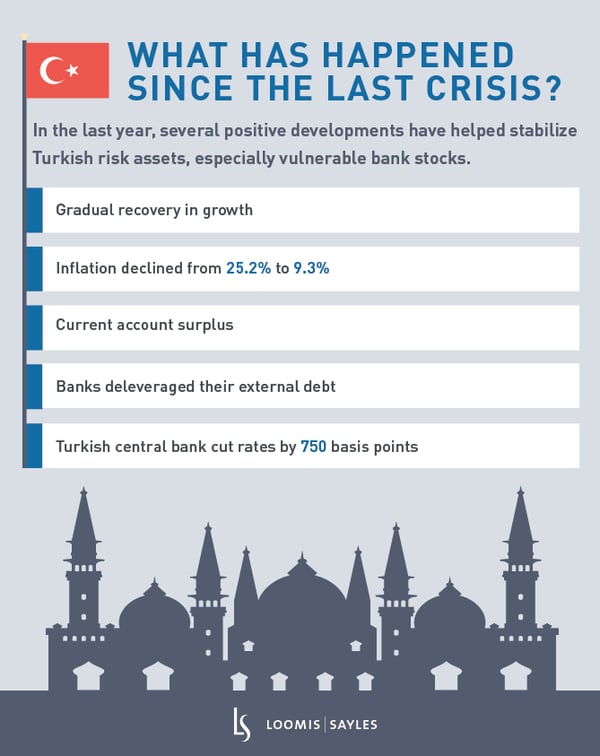Turkey is back in the headlines again. The country launched a military offensive into Syria and is now facing United States sanctions, and one of its largest state-owned banks has been charged with violating US sanctions on Iran. As a result, Turkish equities, bonds and the lira have all come under pressure. Investors’ wounds are still fresh from last year’s currency crisis, which pressured the balance sheets of the country's banks and sent the economy into a tailspin.
In the Turkish banking sector, valuations currently look cheap and macroeconomic conditions have been favorable. Do Turkish banks offer opportunity, or could investors get burned again? Below, I examine what’s going on in the sector and where it could go from here.

The influence of the Turkish Central Bank
The central bank’s rate cuts, largely due to lower inflation expectations and government pressure, have been particularly positive for Turkish banks because their deposits reprice faster than longer-term loans. The market expects the central bank to cut rates again as lower inflation expectations persist and government growth targets have increased.
Typically, I’d expect rate cuts to lead to an improvement in the net interest margins (NIMs) of Turkish banks over the next several quarters. However, the latest crisis has stoked risk aversion, and if the lira continues to depreciate, the central bank may have to pause or even increase rates, which could stall out the recovery in bank profitability.
Central bank policy may have the greatest impact on state-owned banks. These banks suffered the most from interest rate hikes put in place last year to help stabilize the currency, and they could benefit the most from recent and continued rate cuts. But Turkish state-owned banks have a bad reputation for corporate governance; they are viewed as the government’s agent for directed lending at the expense of shareholder profitability. In my view, fundamental profitability drivers, such as an expansion in NIMs, would need to significantly improve to compensate for the corporate governance overhang, especially in light of recent events.
Balance sheet cleanup on shaky ground
Earlier this year, Turkish banks were on the right track. In September, the banking regulator, Banking Regulation & Supervisory Authority (BRSA), asked the country's banks to recognize all their non-performing loans (NPLs) and set aside required reserves by the end of this year. This move was helping the banking sector slowly get out of its asset quality morass after last year's crisis. Though provisions for NPLs hurt profitability in the near term, longer term I expected the measures to improve transparency of bank balance sheets, lower the expense of bad loans (cost of risk), and strengthen earnings.
However, recent events could complicate this progress. An increase in interest rates, depreciation of the lira or a pullback in growth could jeopardize the recovery in bank asset quality and the process of lowering their cost of risk. While NPL recognition by BRSA is a step in the right direction, these NPLs are still a small percentage of the total restructured loans in the Turkish banking system. These restructured loans are sitting on bank balance sheets while the banks hope economic growth picks up next year so companies start making their payments. Banks have delayed recognizing some of their losses through restructuring but they cannot indefinitely kick the can down the road.
Do Turkish banks offer value?
Before the crisis, I thought the mix of a low 2019 earnings base, low interest rates and lower cost of risk going forward could help Turkish banks realize significant earnings growth and return-on-equity expansion over the next 12 months. This would have supported price-to-earnings multiple expansion. However, the prospects of this scenario have diminished with recent events. Further, I believe the cost of equity (CoE) for bank stocks could also go up materially. The recent increase in risk perception has increased bond yields and the CoE for Turkish bank stocks, which could delay Turkey’s recovery and the multiple expansion that the market and I had expected.
Recently, forward price-to-book (P/B) multiples for Turkish bank stocks have been well below the median of the past 10 years. Though the sector looks cheap based on P/B multiples, there are a number of challenges, especially for the state-owned banks. Capital adequacy is still weak, especially in light of the restructured loan exposures, and foreigners have almost no interest in putting more capital into the system. In an environment of increasing geopolitical and inflationary uncertainty, NPL provisioning could add stress to the relatively weak capital position of the state-owned banks. The current exodus of foreign investors could compound these challenges. If there are no external investors interested in re-capitalizing the sector, the state may have to intervene, likely leading to deterioration in risk premiums and CoE. In short, I don't think there's real value in Turkish banks at this time. I'd wait until we have some clarity on the resolution of the current geopolitical turmoil.
MALR024451
Market conditions are extremely fluid and change frequently.
This blog post is provided for informational purposes only and should not be construed as investment advice. Any opinions or forecasts contained herein reflect the
subjective judgments and assumptions of the authors only and do not necessarily reflect the views of Loomis, Sayles & Company, L.P. Information, including
that obtained from outside sources, is believed to be correct, but Loomis Sayles cannot guarantee its accuracy. This material cannot be copied, reproduced or
redistributed without authorization. This information is subject to change at any time without notice.




